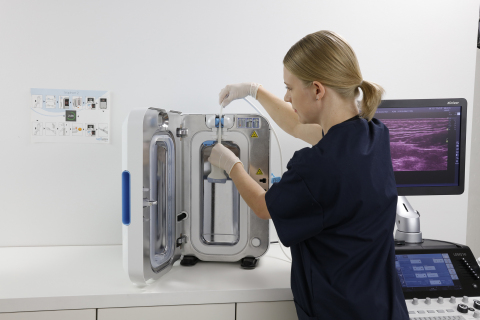Nanosonics (ASX: NAN), a leader in infection prevention solutions, announced the commercial availability of its trophon®2 high level disinfection (HLD) system for ultrasound probe decontamination in the United States and Canada. The new device, which prevents exposure to hazardous chemicals, offers medical professionals a smart solution that helps ensure compliance with the latest guidelines for reprocessing of surface and endocavity ultrasound probes. The system is also equipped with an automatic traceability solution that creates audit-ready digital records of each HLD cycle with the option for IT integration.
This press release features multimedia. View the full release here: https://www.businesswire.com/news/home/20181003005267/en/

Nanosonics’ trophon®2 High Level Disinfection System with surface ultrasound probe being placed in system for decontamination process. (Photo: Business Wire)
Initial feedback from customers in North America implementing trophon2 as standard-of-care for HLD probe reprocessing is resoundingly positive. Nanosonics will showcase the new device and its suite of HLD products at the 2018 Society of Diagnostic Medical Sonography (SDMS) Annual Conference in Orlando, Fla., Oct 4-7.
“As momentum continues to build for our innovative trophon technology in North America, we are excited to offer our second-generation system to hospitals, clinics and medical offices as a complete HLD solution that addresses the risks presented by improper ultrasound probe reprocessing while significantly improving workflow,” said Ken Shaw, president of North America for Nanosonics. “Early excitement about trophon2 underscores the importance of this system and its ability to deliver superior decontamination while safeguarding medical staff, patients and our environment from toxic side effects of traditional disinfection. In addition, trophon2 ensures that our customers are audit-ready and able to meet disinfection and traceability requirements utilizing the electronic track and trace features offered with our AcuTrace™ and AcuTrace™ PLUS, thereby simplifying and improving workflow in hospitals and clinics considerably.”
Nanosonics’ trophon technology is installed in more than 4,000 hospitals and facilities in North America including all of the top 50 U.S. hospitals*. Consequentially, it is estimated that trophon technology is currently protecting over 50,000 patients every day from the risks of cross contamination, a number that is growing daily.
Ultrasound imaging is one of the fastest growing medical procedures due in part to its expanded use across multiple medical specialties1. While ultrasound is safe, there are risks of cross contamination if probe reprocessing is not performed correctly. Global guidelines now recommend HLD between patients for ultrasound probes used in semi-critical procedures, including intracavity procedures, and for surface ultrasound procedures on non-intact or broken skin, to effectively reduce the risk of infection for patients and staff.
Yet, adhering to HLD best practices is not routinely implemented on several ultrasound procedures that require it. This was recently highlighted by a survey published in the American Journal of Infection Control, showing that there are a large number of procedures where HLD is not being performed between patients. Improper infection prevention practice associated with ultrasound probe use has been linked to increased infection risk, outbreaks and death2.
According to Raleigh White, CRA, RT(R), MA, director of Imaging Services at Hutchinson Regional Medical Center in Kansas, “Since implementing trophon technology as our infection prevention standard of care for ultrasound probe reprocessing, we are significantly more effective at high level disinfection throughout our facility. Even though ultrasound is one of the safest and widely-used imaging modalities today, following best practices and eliminating the risk of infection transmission between patients was often time-consuming and required the use of toxic chemicals as well as the need for a special ventilation system within our facility.
“With trophon HLD, the transducer decontamination process is quick, simple and doesn’t require hazardous chemicals,” continued White. “Equally as important, the confidence amongst our sonographers in their ability to eliminate the risks of infection transmission has been raised exponentially since adopting trophon. During my career, I’ve had several Joint Commission surveyors observe the trophon HLD process and I have been told repeatedly that it is the gold standard for maintaining patient and user safety.”
The automated trophon2 generates a sonically activated, supercharged hydrogen peroxide (H2O2) mist that kills drug-resistant bacteria, fungi and viruses. The device is validated for use with over 1,000 different probes across all major ultrasound companies, and offers an effective traceability solution with AcuTrace, capturing required information to create audit-ready digital disinfection records. The platform also offers the option for hospitals to integrate trophon2 into their IT systems with AcuTrace PLUS, thereby centrally storing disinfection records for easy access by the entire IT system and linking information directly to patients’ electronic medical records.
About Nanosonics
Nanosonics (ASX:NAN) is a leading medical technology company headquartered in Sydney, Australia, with its North American operations based in Indianapolis. Founded in 2001, the company is one of Australia’s largest medical technology companies and a recognized leader in its sector of the global infection control market. Nanosonics develops infection prevention solutions including the trophon® EPR system, the first major innovation in high level disinfection (HLD) for ultrasound probes in over 20 years. The company is launching its second-generation trophon2 HLD system in North America offering innovative functionality to further optimize ultrasound probe decontamination. More information may be found at: www.nanosonics.us.
*US News and World Report.
1. https://www.healthimaging.com/topics/healthcare-economics-policy/8-global-ultrasound-markets-poised-strong-2018
2. GOV.UK Medical Safety Alert; Reusable transoesophageal echocardiography, transvaginal and transrectal ultrasound probes (transducer) – failure to appropriately decontaminate. (https://www.gov.uk/drug-device-alerts/medical-device-alert-reusable-transoesophageal-echocardiography-transvaginal-and-transrectal-ultrasound-probes-transducers-failure-to-appropriately-decontaminate)
View source version on businesswire.com: https://www.businesswire.com/news/home/20181003005267/en/


